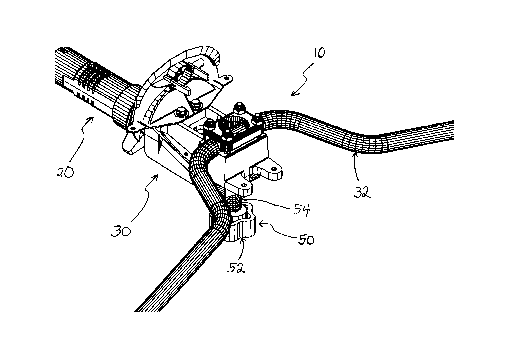Some of the information on this Web page has been provided by external sources. The Government of Canada is not responsible for the accuracy, reliability or currency of the information supplied by external sources. Users wishing to rely upon this information should consult directly with the source of the information. Content provided by external sources is not subject to official languages, privacy and accessibility requirements.
Any discrepancies in the text and image of the Claims and Abstract are due to differing posting times. Text of the Claims and Abstract are posted:
| (12) Patent Application: | (11) CA 2220128 |
|---|---|
| (54) English Title: | ADJUSTABLE STEERING COLUMN |
| (54) French Title: | COLONNE DE DIRECTION REGLABLE |
| Status: | Deemed Abandoned and Beyond the Period of Reinstatement - Pending Response to Notice of Disregarded Communication |
| (51) International Patent Classification (IPC): |
|
|---|---|
| (72) Inventors : |
|
| (73) Owners : |
|
| (71) Applicants : |
|
| (74) Agent: | SMART & BIGGAR LP |
| (74) Associate agent: | |
| (45) Issued: | |
| (22) Filed Date: | 1997-11-04 |
| (41) Open to Public Inspection: | 1999-05-04 |
| Availability of licence: | N/A |
| Dedicated to the Public: | N/A |
| (25) Language of filing: | English |
| Patent Cooperation Treaty (PCT): | No |
|---|
| (30) Application Priority Data: | None |
|---|
An adjustable steering column for use with a personal watercraft or similar
vehicles.
The adjustable steering column comprises a steering column base fixed to the
watercraft, an
upper steering column connected to the steering column base, the upper
steering column
being moveable between a first position and second position, and an adjustment
mechanism
for moving the upper steering column between the first and second positions.
Preferably, the
adjustment mechanism includes a screw with a knob on one end and a ball joint
on the other
end. The adjustment screw is manually operable to pivot the upper steering
column with
respect to the steering column base. An adjustable steering column allows
riders of different
size to vary the height and angle of the steering column to optimize comfort
and control.
Note: Claims are shown in the official language in which they were submitted.
Note: Descriptions are shown in the official language in which they were submitted.

2024-08-01:As part of the Next Generation Patents (NGP) transition, the Canadian Patents Database (CPD) now contains a more detailed Event History, which replicates the Event Log of our new back-office solution.
Please note that "Inactive:" events refers to events no longer in use in our new back-office solution.
For a clearer understanding of the status of the application/patent presented on this page, the site Disclaimer , as well as the definitions for Patent , Event History , Maintenance Fee and Payment History should be consulted.
| Description | Date |
|---|---|
| Inactive: IPC expired | 2020-01-01 |
| Inactive: IPC from MCD | 2006-03-12 |
| Inactive: IPC from MCD | 2006-03-12 |
| Time Limit for Reversal Expired | 2003-11-04 |
| Application Not Reinstated by Deadline | 2003-11-04 |
| Deemed Abandoned - Failure to Respond to Maintenance Fee Notice | 2002-11-04 |
| Inactive: Abandon-RFE+Late fee unpaid-Correspondence sent | 2002-11-04 |
| Letter Sent | 2000-11-28 |
| Inactive: Cover page published | 1999-05-20 |
| Application Published (Open to Public Inspection) | 1999-05-04 |
| Inactive: Filing certificate - No RFE (English) | 1999-03-25 |
| Inactive: Inventor deleted | 1999-03-25 |
| Inactive: Delete abandonment | 1999-03-24 |
| Inactive: Abandoned - No reply to Office letter | 1999-02-05 |
| Inactive: Correspondence - Formalities | 1999-02-04 |
| Inactive: Correspondence - Formalities | 1998-11-26 |
| Inactive: Office letter | 1998-11-06 |
| Inactive: Single transfer | 1998-08-12 |
| Inactive: First IPC assigned | 1998-02-24 |
| Classification Modified | 1998-02-24 |
| Inactive: IPC assigned | 1998-02-24 |
| Inactive: IPC assigned | 1998-02-24 |
| Inactive: Filing certificate - No RFE (English) | 1998-01-29 |
| Filing Requirements Determined Compliant | 1998-01-29 |
| Application Received - Regular National | 1998-01-28 |
| Abandonment Date | Reason | Reinstatement Date |
|---|---|---|
| 2002-11-04 |
The last payment was received on 2001-10-19
Note : If the full payment has not been received on or before the date indicated, a further fee may be required which may be one of the following
Patent fees are adjusted on the 1st of January every year. The amounts above are the current amounts if received by December 31 of the current year.
Please refer to the CIPO
Patent Fees
web page to see all current fee amounts.
| Fee Type | Anniversary Year | Due Date | Paid Date |
|---|---|---|---|
| Application fee - standard | 1997-11-04 | ||
| Registration of a document | 1998-08-12 | ||
| MF (application, 2nd anniv.) - standard | 02 | 1999-11-04 | 1999-10-20 |
| MF (application, 3rd anniv.) - standard | 03 | 2000-11-06 | 2000-10-20 |
| MF (application, 4th anniv.) - standard | 04 | 2001-11-05 | 2001-10-19 |
Note: Records showing the ownership history in alphabetical order.
| Current Owners on Record |
|---|
| BOMBARDIER INC. |
| Past Owners on Record |
|---|
| DAVID KALHOK |
| LUC LAPOINTE |